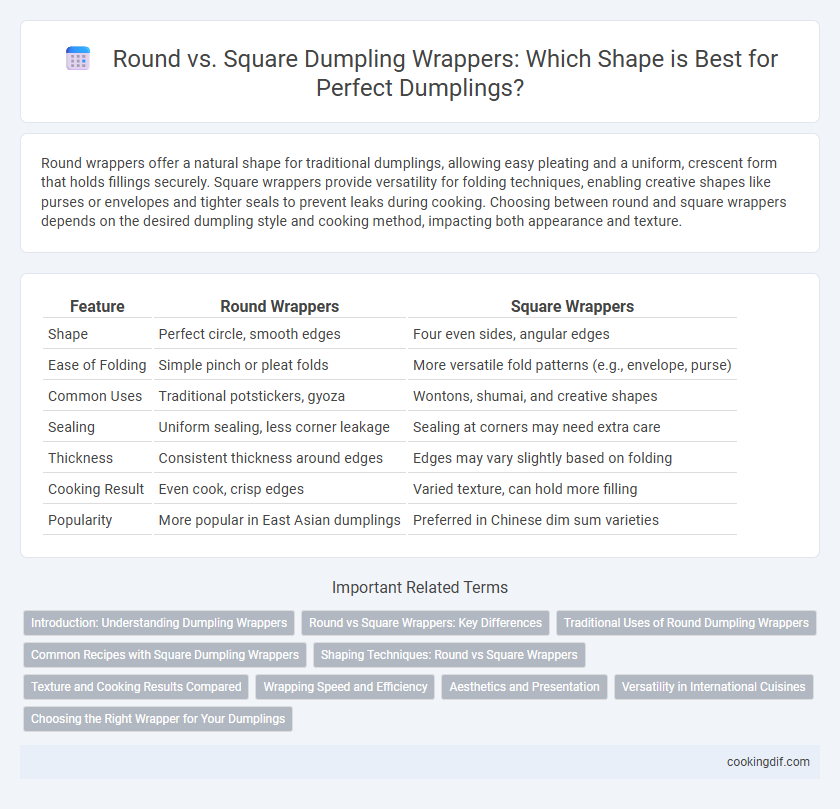Round wrappers offer a natural shape for traditional dumplings, allowing easy pleating and a uniform, crescent form that holds fillings securely. Square wrappers provide versatility for folding techniques, enabling creative shapes like purses or envelopes and tighter seals to prevent leaks during cooking. Choosing between round and square wrappers depends on the desired dumpling style and cooking method, impacting both appearance and texture.
Table of Comparison
| Feature | Round Wrappers | Square Wrappers |
|---|---|---|
| Shape | Perfect circle, smooth edges | Four even sides, angular edges |
| Ease of Folding | Simple pinch or pleat folds | More versatile fold patterns (e.g., envelope, purse) |
| Common Uses | Traditional potstickers, gyoza | Wontons, shumai, and creative shapes |
| Sealing | Uniform sealing, less corner leakage | Sealing at corners may need extra care |
| Thickness | Consistent thickness around edges | Edges may vary slightly based on folding |
| Cooking Result | Even cook, crisp edges | Varied texture, can hold more filling |
| Popularity | More popular in East Asian dumplings | Preferred in Chinese dim sum varieties |
Introduction: Understanding Dumpling Wrappers
Round wrappers offer a traditional approach to shaping dumplings, providing an even, circular canvas that naturally supports pleating and sealing. Square wrappers, however, allow for versatile folding techniques and can create more intricate shapes, often resulting in a sturdier dumpling structure. Choosing between round and square wrappers affects the dumpling's texture, cooking method, and aesthetic appeal, making wrapper shape a crucial factor in authentic dumpling preparation.
Round vs Square Wrappers: Key Differences
Round wrappers offer a smooth, seamless edge ideal for traditional dumpling shapes like potstickers and wontons, enhancing aesthetic appeal and structural integrity during steaming or frying. Square wrappers provide more flexibility for folding techniques, allowing for intricate pleats and varied shapes such as purses or envelopes, which can hold larger or irregular fillings securely. The choice between round and square wrappers depends on desired dumpling style and cooking method, influencing texture, filling containment, and presentation.
Traditional Uses of Round Dumpling Wrappers
Round dumpling wrappers are traditionally favored in Chinese cuisine for shaping classic dumplings like jiaozi and wontons, because their circular form facilitates easy folding and pleating that seals fillings securely. The round shape allows for versatile techniques such as half-moon folds and complex pleats, enhancing both aesthetic appeal and structural integrity during cooking. This traditional choice supports consistent steam or boiling results, preserving the moisture and texture essential for authentic dumpling flavors.
Common Recipes with Square Dumpling Wrappers
Square dumpling wrappers are favored in common recipes like jiaozi and potstickers for their ease of folding and ability to create secure pleats that hold fillings firmly. Their symmetrical shape allows for versatile folding techniques such as pleated half-moons or neat envelopes, resulting in well-sealed dumplings that steam or fry evenly. These wrappers are commonly made from wheat flour dough, providing a tender yet durable texture ideal for a variety of fillings including pork, vegetables, or seafood.
Shaping Techniques: Round vs Square Wrappers
Round wrappers are ideal for creating traditional half-moon shaped dumplings, as their uniform edges allow for seamless folding and pinching, resulting in a smooth, symmetrical finish. Square wrappers offer greater versatility in shaping techniques, accommodating pleats, folds, and intricate designs such as potstickers and wontons, where corners and edges contribute to structural integrity during cooking. Choosing between round and square wrappers depends on the desired dumpling style, texture, and presentation, with each shape supporting specific folding methods that influence the final dumpling's appearance and cooking performance.
Texture and Cooking Results Compared
Round dumpling wrappers create a more uniform thickness that results in tender, evenly cooked dumplings with a smooth, delicate texture. Square wrappers offer more dough at the corners, allowing for creative shaping like pleats or folds that provide a chewier texture and slightly crispier edges when pan-fried. Cooking results vary as round wrappers excel in boiling or steaming for softness, while square wrappers enhance pan-frying textures due to their extra dough edges.
Wrapping Speed and Efficiency
Round wrappers offer faster wrapping speed due to their simple, symmetrical shape that requires less adjustment during folding. Square wrappers provide greater efficiency for intricate folding techniques, allowing precise pleats and a secure seal. Choosing round wrappers enhances speed for mass production, while square wrappers optimize structural integrity in artisanal dumpling making.
Aesthetics and Presentation
Round dumpling wrappers create smooth, symmetrical shapes that highlight traditional elegance and uniformity in presentation. Square wrappers offer versatility, allowing for creative folding techniques that produce visually intricate and unique dumpling designs. Choosing between round or square wrappers significantly impacts the dumpling's aesthetic appeal and can enhance the overall dining experience.
Versatility in International Cuisines
Round dumpling wrappers offer superior versatility across a wide range of international cuisines, easily adaptable to various folding techniques such as pleats, purses, or half-moons common in Chinese jiaozi or Japanese gyoza. Square wrappers, often preferred in making wontons or potstickers, provide structured edges that simplify intricate folds and create distinct shapes favored in Thai and Filipino dumplings. Both shapes cater to diverse culinary traditions, allowing chefs to explore texture and presentation while accommodating a variety of fillings and cooking methods.
Choosing the Right Wrapper for Your Dumplings
Round wrappers are ideal for traditional dumplings like potstickers and wontons, offering easier folding and creating a classic crescent shape that seals securely. Square wrappers provide versatility for various shapes, allowing for intricate pleats and more creative designs, often preferred in recipes requiring a sealed or folded top. Selecting the appropriate wrapper depends on the dumpling style and desired presentation, with round wrappers best for simplicity and ease, while square wrappers suit elaborate folds and formal dishes.
Round wrappers vs Square wrappers for shaping Infographic

 cookingdif.com
cookingdif.com